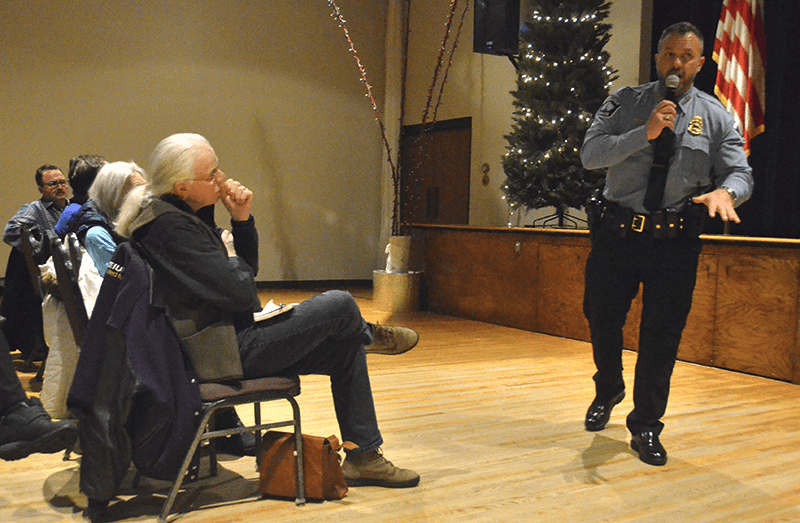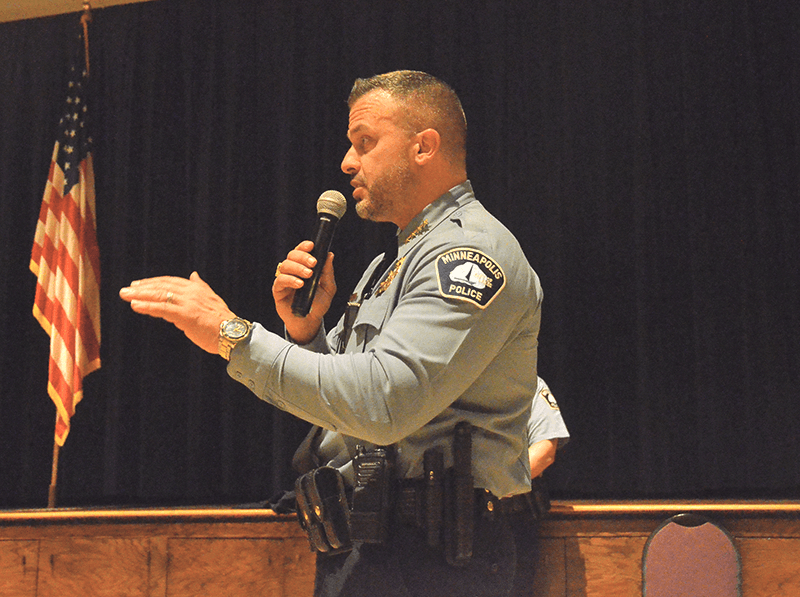Brian O’Hara, the newly appointed Minneapolis Police Chief, stood before an audience of a hundred people at the Ukrainian Center and said, “As cops, we are here to ensure that there are fewer victims of crime and violence. And we are here to act in ways that build trust and support the police and community.”
The 43-year-old O’Hara is a 20-year veteran of the Newark, New Jersey Police Department, a City Safety Director and a Deputy Mayor. He began his three-year term as Chief in November, and attended the Jan.11 meeting at the request of Third Ward City Council member Michael Rainville, who introduced him, saying, “We are the luckiest city, not in North America, but the world. Because we have the finest chief of police in the world.”
O’Hara likened the vetting process he went through to “running for office.” He praised City Council members for what he described as their clear ideas on plans and solutions for public safety issues. He noted that Newark and Minneapolis are very different cities, and their police departments are, as well. But there are similarities: both cities have had serious problems for years with violent crimes and a lack of police engagement with the community. “Living through what I went through and having led police reform efforts and also at the same time trying to lead better models of reducing crime in a collaborative way and being able to sustain it, I think what I’ve learned is that the only way to go forward is to address both of these things at the same time. I know what good policing looks like, I know the investments that we need to make in our police officers, to ensure that they have the training, the resources, and the support that they need to perform in ways that community expects the police department to perform.”
O’Hara spoke at length on the problem of staffing the Department. He said that the loss of hundreds of officers in the last three years has continued, and not enough people have been brought in during that time to match the attrition. He wants to push for reforms, both at the city and the state level, to ensure the ability to screen the type of people that the city wants to see as police officers. “I think it’s unreasonably difficult, the way the structure is here, for kids from cities, and particularly younger people who have significant life experiences that may be of value to the police department, to become cops. For example, if someone from Minneapolis worked as a corrections officer for five years in the jail, and they were able to talk to people there and interact with people, people engaged in street life, and have not had any complaints against them, they’re still not eligible to become police officers in Minneapolis unless they’ve gone through a police college-type program. And I think that’s unfair.”
People no longer wanting to be cops is, in O’Hara’s words, “A crisis across the country, but much more here than elsewhere, and if any police department in America has an image problem that we need to invest in, it’s Minneapolis.” He added that people who want to be a part of the change will need to be connected to the community to give them a pathway to do so.
O’Hara responded to an audience question about an expected consent decree against the police department from the Minnesota Department of Civil Rights, saying that the action will mandate certain reforms to be made through court orders, “And those reforms don’t implement themselves. I want people to know that the city will have to pay millions of dollars to monitor the police department. But the only way we’re going to actually get the types of reforms that people want to see is if we make investments into the police department with additional support staff. During the civil unrest in 2020, a number of police officers were fired or suspended over bad behavior … but only the people on the bottom were held accountable. And clearly, leadership should have been involved.”
He said he will draft a policy around a number of these issues, such as use of force. “We would then set up a meeting, like tonight, where we would provide the opportunity to present the policy to the community and get some different perspectives on it, and get written feedback that the police department would have to respond to.” He noted that because the process deals with large bureaucracies, it usually takes years to actually implement any changes.
An audience member asked, in light of the state’s current budget surplus, if there might be additional funding for some of the Department’s needs. O’Hara said he hopes Minneapolis will get its fair share of help for issues that affect public safety. He noted that the Bureau of Criminal Apprehension (BCA) is a small state agency, but they have dedicated resources, and BCA agents help investigate homicides and violent crime and support the city in focused enforcement efforts. The City will be looking at additional funding so that the BCA can maintain the level of support that they are providing to Minneapolis, while at the same time dealing with their responsibilities across the state.
Guns and gun violence were on the minds of more than one audience member. Asked whether gang initiations were a factor in the number of shootings, O’Hara said no.
“The vast majority of gun violence is just nonsense, totally senseless. It’s because some people have no conflict resolution skills and they get into something on Facebook or someone disrespects them in some way when they’re in a bar, or they get into some sort of nonsense argument on the street; it’s very impulsive. And the problem that makes it deadly is there’s too many guns out there. And those types of nonsense, senseless confrontations are what’s causing the vast majority of the problem that we have around gun violence. So it’s not that residents need to arm themselves because gun violence is so arbitrary or random; most of the time it’s people who know each other and have access to firearms and make ridiculously bad choices.”
At several points during the question-and-answer period, the audience responded to the chief’s words with applause. Almost every questioner welcomed the chief and thanked him for showing up. Among them were four women sitting in the front row, wearing orange Neighborhood Safety Watch Club tee shirts. One of them, Aileen Johnson, from the North Loop Club, said, “The Neighborhood Safety Clubs were excited and grateful to be there to welcome Chief O’Hara and hear his remarks. We came away from the evening feeling better informed.”
Two hours after Chief O’Hara left the meeting, he appeared on a live television report, standing in the street at the site of multiple shootings in North Minneapolis.
“There have been a number of shooting incidents over the last few days, and obviously that is very concerning for me. I think this speaks volumes to the challenges we are facing. This is a scene here where from what we know so far there were at least three guns on the scene, and it just shows the crisis we are facing.”
New MPD Police Chief Brian O’Hara spoke to 100 people at a Jan. 11 meeting at the Ukrainian American Community Center. Police Chief Brian O’Hara. (Photos by Mark Peterson)

